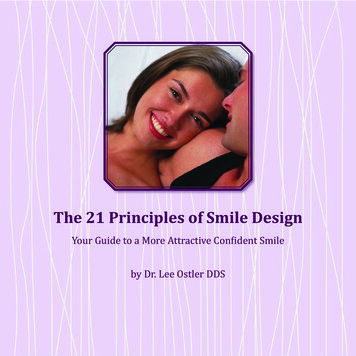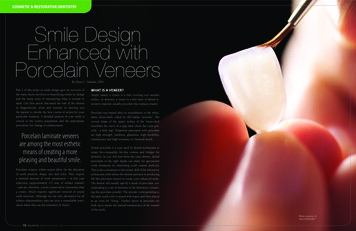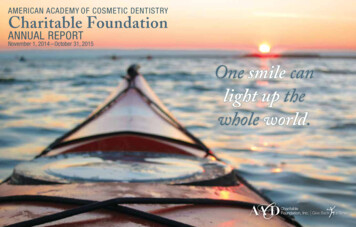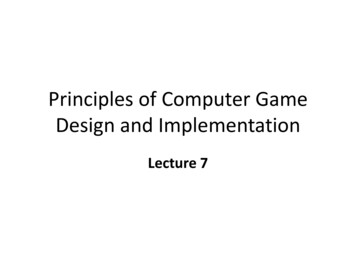
Transcription
The 21 Principles of Smile DesignYour Guide to a More Attractive Confident Smileby Dr. Lee Ostler DDS
The 21 Principles of Smile DesignModern Cosmetic Dentistry and the advent of new materials and techniques have transformed the way people think about their smiles andeach other. Smiles convey warmth, confidence, social status and career success.Best of all, smiles help you feel good about yourself.Today you can trust your smile to a new brand of cosmetic dentist - an artistwho understands exactly what you want in a smile, why you wear it as yourmost important accessory, and how to protect it through the ages. As oneof this regions’ most celebrated cosmetic dentists, Dr. Ostler gives you thewarmth, experience, and passion that you want and deserve in a good cosmeticdentist.Nothing compares to a confident attractive smile. It’s there when you laugh,when you greet, say thank you, or express a happy thought. Your smile is yourmost important social bonding gesture, and your most important professionalannouncement - it tells others who you are. In short, your smile sells you!Give your smile that Picture Perfect look of confidence, beauty and health because when you feel good about yourself, people are naturally attracted tothat!Give your smile that Picture Perfect look of.Confidence, Beauty and Health!2
The 21 Principles of Smile Design3
The 21 Principles of Smile DesignThe Principles ofSmile DesignHow to Have an Attractive SmileThey say you shouldn’t judge abook by its cover - but we all do!One of the first judgments we makewith people is how they smile andhow confident they are. In fact it’sdifficult to not form an immediateopinion about someone based ontheir smile. Smiles say a lot aboutwho a person is, how confident theyare, and even how successful theyare. Like beauty, a smile is more thanskin deep and your face seems toknow if your smile feels confident ornot.Just what makes an attractivesmile? Why do some smiles exudeconfidence and look naturallybeautiful, while others look plain andaverage? How can teeth make oneperson look older and another person4look younger? What makes oneperson’s smile a loser while anotherperson’s smile a real winner - thathelps them do more business, makemore sales, and have more friends?And finally, why do some smilesconvey a careless disregard for healthand self-respect?While most people don’t knowexactly what constitutes a nice smile,most will recognize a nice smile when
The 21 Principles of Smile Designthey see one. While nature has been kind to some, others aren’t so lucky.Fortunately we now understand these principles of nature and exactly whatmakes a nice looking smile look nice. We call these principles the “Principles ofSmile Design”.These rules or principles dictate whether a smile is attractive, average, or awful.Whether these basic rules of smile design are broken by nature, yourself, oryour dentist, your smile and confidence can be seriously compromised. Thegood news is that in the right hands they can be used to create wonderfulsmiles regardless of your starting condition or the quirks of nature. Whenthey’re followed you’ll enjoy a radiant natural looking smile with all the socialand career benefits and peace-of-mind that goes with it.Evaluate your own smile:These smile design principles are easy to understand. In fact you can use theseprinciples to evaluate your own smile. Experienced and highly trained cosmeticdentists use and follow these principles every day in transforming worn out,broken, and aging smiles, into beautiful natural smiles. The results go farbeyond just increasing your “face value” – they are life changing!To be sure, there is both an art and a science to restoring and creating strongattractive smiles. When good cosmetic artistry is combined with modern dentalmaterials and expert training, you can be assured of a durable radiant andhealthy new smile that speaks volumes about who you really are.When it comes to the art, having a pretty smile goes beyond modern5
The 21 Principles of Smile Designtechnology. The ancient Greeksintroduced and understood theimportant parameters of beautycalled the “golden proportion”.These principles have been long usedby renowned and famous artists,builders and designers for thousandsof years.Today, we blend these designprinciples into beautiful smiles bycarefully managing size, shape,alignment and proportion to createa result that is natural and pleasingto the eye. Attractive smiles areattractive because they follow thesebasic rules of nature, and naturalbeauty is something that is veryapparent to the subconscious eye.This is why beauty is so universallyrecognized, and why confidentattractive smiles are noticed andrewarded. It is important that boththe art and the science come togetherto create a balanced harmony and6a pleasing smile that is strong anddurable.Whether it is whiter teeth, orfixing crooked teeth with “instantorthodontics”, or replacing uglydark fillings, or fixing a worn out oldlooking smile - modern dentistry cantake years off your face and quicklyand easily give you the perfect smilethat will allow the real you to emerge.
The 21 Principles of Smile DesignKnowing these Principles of Smile Design will help you better understand whysome people have a great smile while others don’t. It will help you analyze thestate of your own smile, and to know what experienced dentists are looking atas they design your perfect smile.As you review this information, compare your smile with the examples shown.This is an easy way to take the mystery out of “what’s wrong with my smile?”By using these principles it will help you know what can be done to designand create the right smile for you, one that will let your true personality andconfidence emerge.We encourage you to think seriously about the benefits to health, spirit andmind that come from a youthful attractive smile, a balanced bite, and healthystrong teeth. Using these principles of smile design you will discover how youcan make your smile one that is judged warmly and truly announces the “realyou” – one that radiates the confidence and success you intend for yourself.7
The 21 Principles of Smile DesignThe 21 Principles of Smile DesignThe Principles of Smile Design govern how naturally attractive your smile is– or isn’t! When art, science, form and function are blended optimally bynature or an experienced cosmetic dentist, the results can be simply amazing!Experienced cosmetic dentists understand and use these principles to transform dull average smiles into successful confident smiles.There are many elements other than having whiter teeth that make for a radiant or confident smile. Each principle is illustrated with a drawing and with photographs showing good and/or bad examples. While most unattractive smileshave multiple flaws, each example illustrates one principle.You can use this guide as a reference to compare or evaluate your own smile.You may find it helpful to use a mirror or a close-up photograph of your smile asyou go through these principles.8
The 21 Principles of Smile Design#1:Central IncisorWidth / HeightRatioDo your front incisor teeth appear taller than they are wide like an up-rightrectangle, not a square? The width/height ratio should be 75-80 %. Forexample, if the width were 8.0 mm and the height 10 mm, the ratio (8/10)would equal 80%.9
The 21 Principles of Smile Design#2: MesialInclinationAre your teeth angledproperly? Each upper toothvisible in the smile shouldhave a slight inclination ortilt that is toward the midline(mesial) of the mouth. If theseimaginary lines were extendeddownward they would meet orconverge at or near the navel point over the stomach.10
The 21 Principles of Smile Design11
The 21 Principles of Smile Design#3: MidlinePlacementand CantIs your smile centered onyour face and in your mouth?The position of the mid-linebetween the central incisorsshould be on a line drawnfrom between the eyes anddown through the nose,lips and chin. The angle ofthe mid-line should not becanted or tilted to the left orright, but should be straightup and down.12
The 21 Principles of Smile Design#4: Color,Shading, Stains,and MarkingsAre the teeth a uniform bright coloror shade? Is one tooth darker thanthe rest? Are there white or darkspots or markings on the enamel?13
The 21 Principles of Smile Design14
The 21 Principles of Smile Design#5: Smile at RestEvaluate the amount of teeth showingat rest or with a slight smile. Middleaged adults should show 2-4 mmof their upper teeth. This amountdecreases with age as the “window”of the mouth begins to sag downwardshowing more of the lower teeth.15
The 21 Principles of Smile Design#6:Gum LineSymmetryThe gum tissue framesthe teeth and formsa “curtain” for theteeth. Is the heightand scalloping of thegum line symmetricalor matched evenlybetween the left andright sides? Balanceand symmetry areimportant partsof what makes anattractive smile.16
The 21 Principles of Smile Design#7:Gum LineMarginHeightsIs the level of the gum line over the lateral incisor lower than the centralincisor? The height of the gum line margin over the lateral incisors should beslightly lower than the height of the gums over the adjacent central incisor andcanine teeth.17
The 21 Principles of Smile Design#8:Gaps orDiastema:A “diastema” is a gap between the teeth. Is there a space between your frontteeth?18
The 21 Principles of Smile Design#9:Gummy SmileA “gummy smile” is when too muchgum tissue shows above your frontteeth when you smile. How muchgum tissue shows with a full happysmile? Ideally there should be onlya slight amount (1 to 3 mm) of gumtissue showing above the front teethwhen you smile.19
The 21 Principles of Smile Design#10:Gingival ZenithWhat is the location of the uppermost height of the gum line over each tooth?The height of the gum line across the face of each tooth varies from tooth totooth. It should be centered over each lateral incisor, and it should be 2/3rds ofthe way across the face of the tooth for the central incisors and canine teeth.20
The 21 Principles of Smile Design#11:Smile LineFollows LipDoes your smile linegenerally follow your lowerlip line? The incisal orbiting edge of the upperteeth should parallel orfollow the contour of thelower lip line in a relaxedor slight smile.21
The 21 Principles of Smile Design#12:HorizontalPlaneAre your teeth on aparallel horizontal planewith your eyes or withthe floor? The left to righthorizontal biting plane ofthe mouth should parallelthe floor or the horizonwhen standing. It shouldalso parallel a line drawnbetween the eyes (theinter-pupillary line). Thehorizontal plane fromthe front to the back ofthe mouth should alsogenerally parallel the floor.(Note: some people’s eyesare not level in nature.)22
The 21 Principles of Smile Design#13: GumTissueHealth/BadBreathDo your gums bleedwhen you brush or floss,or are they inflamed orred around the borders?Healthy gums do not bleedand are light pink in colorand are stippled in texture(like an orange peel). Gumdisease is linked to heartdisease and can be veryunsightly – and smelly!Oral bacteria cause toothdecay, gum disease andbad breath! Any plan for anattractive smile and goodoral health must includeregular dental cleaningsand good oral hygienepractices.23
The 21 Principles of Smile Design#14:FlossingContactPointDoes the pointof tooth contactbetween front teethgradually migrateupwards fromtooth to tooth? Theflossing contact pointbetween these teethshould step upwardwith each tooth.24
The 21 Principles of Smile Design“Thanks to Dr. Lee Ostler and the principles of Neuromuscular Dentistry, Inow have the beautiful smile I’ve always wanted. My bite feels comfortable atlast and my headaches have improved significantly.” Vicki Coogan25
The 21 Principles of Smile Design#15:Mal-alignment or CrowdingTeeth should be even and straight. Are your teeth crooked or crowded in theirpositioning? Is there room for your teeth in a natural arch form with each toothstanding evenly side by side? Crowding happens when there isn’t enough roomfor them or when the jaws are too small.26
The 21 Principles of Smile Design#16:IncisalEmbrasureIs there good definitionand separation betweenthe front teeth on theincisal edge of the teeth?The size of the silhouetteor outline shape betweenthe front teeth shouldsymmetrically increase insize moving away from themidline. This is best seenas a triangle shape wedgebetween the teeth and onthe biting edge of the frontteeth.27
The 21 Principles of Smile DesignThe Golden Proportionwas used in ancient Greekarchitecture and in thegreat art of the ages. It canbe observed throughoutnature and the humanbody. Its principles areused in modern buildingconstruction, car designand clothing. The balanceand harmony it creates ispleasing to the eye.Cosmetic dentists usethe Golden Proportion tocreate a pleasing smile thatis balanced with the face.28
The 21 Principles of Smile Design#17: GoldenProportionRatioAre your teeth sized in the properproportion? The Golden Proportionfollows the “rule of thirds”. Eachtooth away from the midlineshould be two-thirds as wide asthe previous tooth. For example:Measure the width of a centralincisor in your mouth or on aphotograph. Divide this width bythe width of the lateral incisor nextto it. The central incisor should be1.6 times as wide as the lateral,and the canine 0.6 times as wide asthe lateral, and so forth.(Example: Ideally, if the centralincisor is 10 mm wide, the lateralincisor should be two-thirds of thisamount, or about 6.5 mm, and thecanine should be two thirds of thator about 4.4 mm)29
The 21 Principles of Smile Design#18:BlackTriangleIs there a dark space at the gum line between the front teeth? A “blacktriangle” appears between the front teeth when the teeth are too far apart orthe underlying bone level dissolves away. When this happens, the gum papillashrinks and allows the
by Dr. Lee Ostler DDS. 21 sign 2. M. odern Cosmetic Dentistry and the advent of new materials and tech-niques have transformed the way people think about their smiles and each other. Smiles convey warmth, confidence, social status and career success. Best of all, smiles help you feel good about yourself. Today you can trust your smile to a new brand of cosmetic dentist - an artist who .











